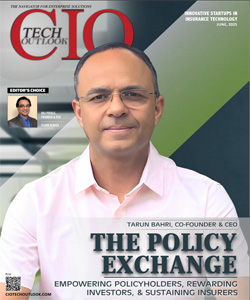Green IT: Sustainable Practices Every CIO Should Implement
Janifha Evangeline, Assistant Editor, CIOTechOutlook | Saturday, 06 July 2024, 15:17 IST

One of the leading global technology service providers - Logicalis, states that the key priority for tech leaders in 2024 is sustainability. According to Logicalis’ 10th annual CIO report, which surveyed 1000+ CIOs globally, this year almost 92 percent CIOs are investing in sustainability initiatives or technologies.
Reflecting on the findings at Logicalis' Global CIO summit in London, Bob Bailkoski, Logicalis CEO, said: "Investing in sustainability is not only the right thing to do, it's a commercial imperative for business. We know that a reduction in carbon and energy consumption also means lower costs, and with regulations on carbon reporting becoming more stringent, prioritising sustainability now will serve CIOs well later."
CIOs in today’s rapidly evolving technological landscape as leaders who are responsible for overseeing IT infrastructure play a crucial role in steering organizations towards sustainable practices. CIOs are in a unique position for driving initiatives which not only enhance operational efficiency but also contribute to environmental sustainability. CIOs can not only facilitate companies in reducing their carbon footprint but also promote resource efficiency & foster a culture of sustainability. In this article let us look at the various key sustainable practices which every CIO should consider.
Promote Green data centers
Implementing green data centers is crucial for companies which maintain their own data centers & CIOs have to prioritize energy-efficient hardware which consume less power & generate less heat. Using advanced cooling solutions which include liquid cooling or free cooling can help in reducing energy usage further. Furthermore, utilizing renewable energy sources for powering data centers can help in decreasing their carbon footprint significantly. CIOs can ensure their data centers operate as sustainably as possible through continuous monitoring & optimizing energy usage.
“The rise of green data centres shows us how the IT sector is seeing a shift in how environmental impact and sustainability are being approached. Businesses are proactively looking to these environment-friendly facilities as a solution to the growing concerns about climate change, seeing that they can reduce the typically large carbon footprint associated with data centres,” says Sachin Bhalla, Vice President-Secure Power Division, India and SAARC, Schneider Electric India.
“For a considerable amount of time, the traditional data centre sector has been associated with high energy usage and consequent carbon emissions. Green data centres provide a more ecologically conscious option,” he adds.
Embrace Cloud Computing
Adopting cloud computing is one of the most important steps that CIOs take towards sustainability. Organizations can reduce their energy consumption significantly by migrating to cloud-based services. Also, cloud service providers operate data centers which are far more energy-efficient than the on-premises data centers. By leveraging advanced cooling techniques, economies of scale & renewable energy sources these providers minimize their environmental impact. Furthermore, cloud computing renders scalability which helps businesses in adjusting their resource usage based on the demand, therefore, avoiding over-provisioning & unnecessary energy consumption.
The integration of analytics can help partners and businesses estimate GHG emissions based on the energy consumption of cloud-based services in the data center. Improving cooling efficiency may also help companies monitor the surrounding temperature of data centers by monitoring additional servers, switches, and storage,” says Pallavi Arora, Vice President at Cisco Customer Experience Centers.
Virtualization & Consolidation
By running numerous virtual machines on a single server Virtualization technology helps CIOs in maximizing the usage of physical hardware. This process helps in enhancing resource utilization as well as lower energy consumption by reducing the number of physical servers required. Server consolidation complements virtualization efforts where several workloads are combined onto fewer servers. Also, organizations can not only achieve substantial energy savings reducing the number of servers and maximizing their usage but also lower their environmental impact.
“Virtualization technologies and cloud computing play a pivotal role in sustainable data storage. By consolidating physical servers into virtual machines, organizations can achieve higher server utilization rates, reducing the energy required to power and cool hardware,” states Manish Gupta, Vice President, Infrastructure Solutions Group, Dell Technologies India.
Support Circular Economy Initiatives
The concept of circular economy can contribute to sustainability to a greater extent as the products & materials are refurbished, reused & recycled. CIOs must support the initiatives which promote the circular economy within the Information Technology sector. This comprises the process of implementing programs for reusing & refurbishing IT equipment as well as collaborating with various vendors who provide take-back & recycling services. Also, CIOs can contribute to a more sustainable future by reducing waste, & conserving resources.
Optimize IT Asset Lifecycle Management
The responsible procurement, usage as well as disposal of technology assets are some of the effective phases in IT asset lifecycle management. Also, CIOs have to prioritize purchasing energy-efficient devices as well as consider the total cost of ownership which comprises energy consumption while taking procurement decisions. Waste can be reduced by extending the lifespan of IT assets via upgrades & regular maintenance. CIOs must ensure that assets should be disposed of responsibly when they reach the end of their useful life either through donation programs or recycling, which will help in reducing their environmental impact.
CIOs have a pivotal role in bolstering sustainable practices within their companies. CIOs can improve energy efficiency & decrease their environmental impact by embracing cloud computing, implementing virtualization & promoting green data centers. Furthermore, CIOs must measure & reduce their carbon footprint, foster partnerships with sustainable vendors and support circular economy initiatives. CIOs can lead their companies towards a more sustainable & environmentally responsible future through the aforementioned comprehensive efforts.




